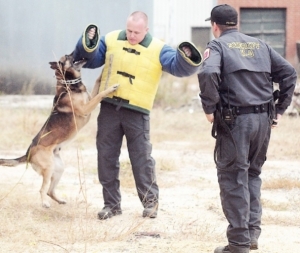Diminished force: K-9 officers becoming endangered species
By Gary Popp
Published in News on December 2, 2010 1:46 PM

News-Argus/MICHAEL K. DAKOTA
Wayne County K-9 officer Remco is one of the dogs used by the Wayne County Sheriff's Office to track and control criminals.

News-Argus/MICHAEL K. DAKOTA
Wayne County Sheriff's Office K-9 Linda clamps down on the bite suit during training.
Over the past year, the K-9 unit at the Wayne County Sheriff's Office has dwindled from six to three dogs and Sheriff Carey Winders says because of increased demand for their services, replacing them is difficult
The unit lost half of its four-legged force due to the retirement of two dogs and the death of a third.
With a smaller unit, the dogs and their handlers are putting in extra hours. If a dog team is needed when none is on duty, one of the deputy handlers, Ryan Sasser, Randy Thompson or Blake Ferrell, is called in.
"We get called out a lot," Sasser said. "Sometimes it comes at the most inconvenient times, but you've got to suck it up and head out. There are a lot of times you are lying in bed at 2 or 3 o'clock in the morning and you get called out. And you've got to go," Sasser said.
The dogs don't just help the Sheriff's Office in its work. They are often requested by other area law enforcement agencies who do not have dogs. The Wayne County K-9 teams have been called from as far away as Roanoke, Va.
Winders said the availability of dogs is the biggest problem in restoring the unit to its full strength. The increased need for dogs for national security at airports and borders and U.S. military operations overseas have made the dog widely coveted.
"The dogs are hard to get right now," Winders said. "It took us over a year to get a dog in the past."
Winders said it is not only a matter of finding the right dog.
"We also have the challenge of finding the right type of person to handle the dog," Winders said. "A dog handler is a special person."
Dog handlers carry a lot of responsibility, the sheriff said.
"A K-9 is not like a machine. You can't cut off. If you go on vacation, you have to arrange for the dog to be fed and cared for," said Winders.
"It takes a big toll on your family, having to do so much with the dogs," Thompson said. "Your family has to support you because if you don't have a family that backs you up, it's hard."
The dogs serving on the K-9 teams are Belgian Malinois imported from Holland. The breed is the most popular for law enforcement work. They are smaller, more agile and tend to have fewer health problems than some other breeds, Sasser said.
Sasser said the Malinois can typically provide eight to 10 years of service, about two years more than German Shepherds.
"These dogs give you more bang for your buck," Sasser said.
As the dogs are born and receive their initial training in Holland, they are accustomed to hearing the Dutch language. Handlers have to learn to give nearly 25 commands in Dutch. That has the additional benefit of keeping the dogs from responding to anyone but his handler, Sasser noted.
"This is especially beneficial in a crowd, so other people don't distract the dogs. If the dog hears a word he doesn't understand, he isn't going to pay attention to it," Sasser said.
The dogs are kept in working condition through two eight-hour training sessions a month.
At a recent training session the handlers put the dogs Linda, Remco and Shelly through real-world conditions. The deputies set up mock searches in an abandoned warehouse, tractor trailer, school bus and minivan. Training included searching for narcotics and evidence, such as firearms.
Other aspects of training include tracking and assisting an officer in making an arrest. Dogs live with their handler to ensure a close bond.
"Learning your dog and learning what to look for in your dog is what makes a good team," Sasser said. "Once you get a bond with your dog, it's like clockwork."
Although the work is serious, the dogs consider it fun.
"The dogs don't care that they are looking for narcotics or a cadaver, they just want the reward," Sasser said.
When training to locate items, the dog is shown a toy that it correlates to the item the handler wants the dog to locate. The handlers put the dog in the area of the item where it picks up the scent. As soon as the dog locates the item, the handler immediately rewards the dog by giving it the toy and enthusiastic praises.
"The toys that the dogs have are specific to the type of the item the dog has found. We have about six different toys for each function the dog performs," Sasser said.
Winders said he hopes to be able to add at least one dog in the coming year.
